Contributory members are able to log private notes and comments about each site
Sites Anne T has logged. View this log as a table or view the most recent logs from everyone
Anglo Saxon Cross Base, Wetheral Parish Church
Date Added: 12th Apr 2016
Site Type: Ancient Cross
Country: England (Cumbria)
Visited: Yes on 28th Feb 2016. My rating: Condition 3 Ambience 4 Access 5
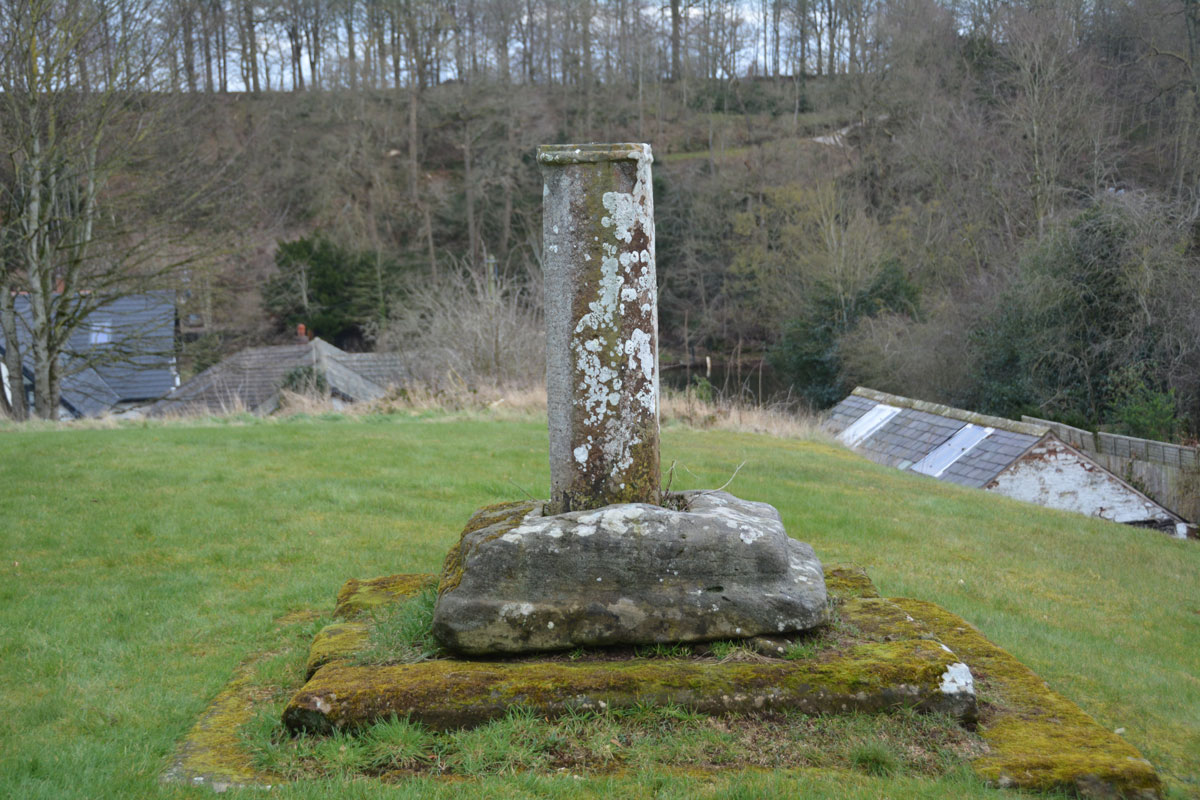
Anglo Saxon Cross Base, Wetheral Parish Church submitted by Anne T on 2nd Mar 2016. Standing to the west of the cross base looking down Ferry Hill towards the River Eden.
(View photo, vote or add a comment)
Log Text: Anglo Saxon Cross Base, Wetheral, Cumbria: A notice in the guard house at the Priory Gatehouse mentioned boundary crosses, so I thought it might be worth investigating whether or not there were any fragments inside the church. As we walked up from the Eden River up Ferry Hill, with the churchyard to my right, there was a fragment of cross shaft with what looked to be an original cross base.
The church itself was locked, although there appeared to be a light on inside, but only in the vestry. A check on the Anglo Saxon Corpus site tells me that only one fragment of cross arm is recorded for Wetheral, and this is now in the possession of H M Calvin of St John’s College, Oxford (see Corpus of Anglo Saxon Stone Sculpture Record Cumbria 169). The cross base isn't recorded on the AS Corpus site, and I'll email for their opinion, but it looks so similar to others that we concluded it must be. I'll update the record when I hear.
St Cuthbert's Holy Well
Date Added: 12th Apr 2016
Site Type: Holy Well or Sacred Spring
Country: England (Cumbria)
Visited: Yes on 28th Feb 2016. My rating: Condition 3 Ambience 3 Access 4
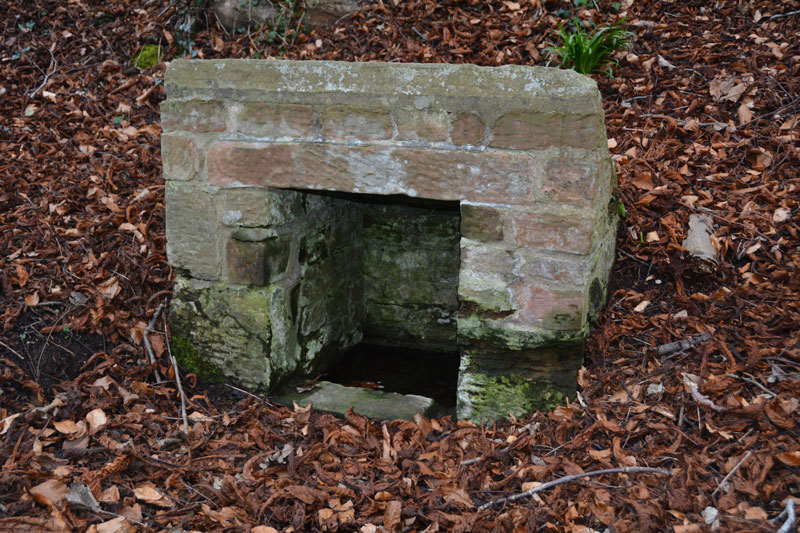
St Cuthbert's Holy Well submitted by Anne T on 2nd Mar 2016. The front and interior of St. Cuthbert's Holy Well. At the time of our visit, whilst the basin inside the well was full of clear water, there was little or no visible flow, unlike the spring opposite Wetheral Priory Gatehouse further up the village.
(View photo, vote or add a comment)
Log Text: St. Cuthbert's Well, Wetheral, Cumbria: I'd tried the (very pretty) walk along the recently flooded River Eden to St. Constantine's Cells, but failed as the path overhangs the river by some 5-6 metres. As a consequence, I was determined to go to this well. Just as you arrive into Wetheral village from the A69, there is a footpath sign leading off to the left, indicating St. Cuthbert’s Well.
There is parking outside the small railway station (there are just a couple of platforms here) and it’s about quarter of a mile down the slope towards the river to the well. A small sign sits to the right of the track as you head towards the river detailing a short history of the well. “According to legend, St Cuthbert’s Well was built long before Norman times when Wetheral Priory was founded. The exact date is not known, but St Cuthbert is thought to have visited Carlisle in 683 and 687.”
From the sign, the well can be seen topped by a concrete slab which has an inscription which reads: “The Holy Well/Called in the 12th century/Fons Sancti Cuthbert/Repaired 1897 and 2001.” A short flight of stone steps leads down to the well itself.
When visiting the village, the Wetheral Priory Gatehouse at the far side of the village is small but worth a visit.
Elvaplain
Date Added: 23rd Jul 2017
Site Type: Stone Circle
Country: England (Cumbria)
Visited: Saw from a distance on 29th May 2016. My rating: Condition 3 Ambience 4 Access 4
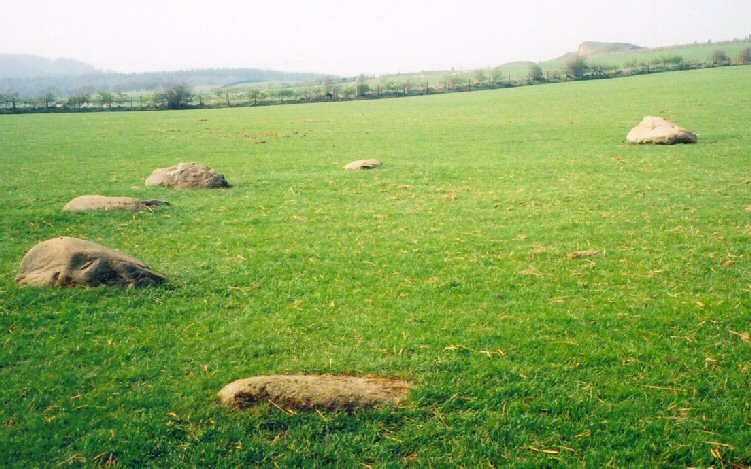
Elvaplain submitted by LizH on 29th Aug 2007. A closer picture of the stones in the circle
(View photo, vote or add a comment)
Log Text: Elvaplain Stone Circle, Setmurthy, Cumbria: After having seen the tumulus and settlements at Aughertree Fell we set off for Elva Hill. With a stunning image on the Visit Cumbria website, which told us this although this stone circle was on private land, it could be approached by a footpath, we found Elva Plain farm and the footpath up to Elva Hill easily enough. With well kept sheep and their large lambs, we enjoyed the sunshine as we walked up the hill. But, and there was a big BUT - the farmer had tied the gates up so strongly with thick twine it was like trying to untie the Gordian knot. With four gates to get through, and some of them wired shut, we could only see this stone circle from afar. Frustrating. If the farmer had been around, I would have asked (nicely) for access to the field. Whilst the stones are largely flat and just visible above ground (between the sheep!), this stone circle is in a stunning location, looking out over Bassenthwaite Lake in the valley to the south west and the fells beyond. Elva Hill (now quarried) lies to the north.
Hadrian's Wall (Poltross Burn)
Trip No.143 Entry No.1 Date Added: 11th Jul 2019
Site Type: Stone Fort or Dun
Country: England (Cumbria)
Visited: Yes on 8th Jul 2019. My rating: Condition 3 Ambience 4 Access 4
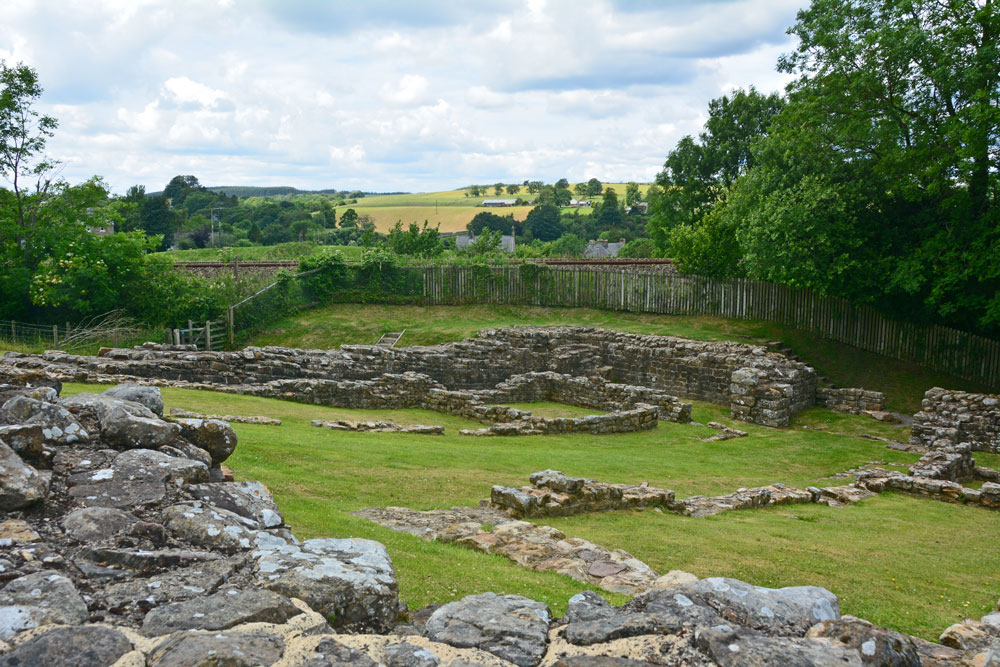
Hadrian's Wall (Poltross Burn) submitted by Anne T on 11th Jul 2019. Standing at the south western corner of the milecastle/small fort, looking towards its north eastern corner.
(View photo, vote or add a comment)
Log Text: Poltross Burn Milecastle: We last visited this site on 27th October 2013, and it hasn’t’ changed at all. Andrew, in typical engineering fashion, went round and talked about the offsets and revetted construction of this small fort. It’s layout is remarkably easy to read.
Andrew recalled reading about a house built right on top of the wall, but we were unable to find it.
Clifton Stones
Trip No.3 Entry No.2 Date Added: 4th Jul 2016
Site Type: Standing Stones
Country: England (Cumbria)
Visited: Yes on 3rd Jul 2016. My rating: Condition 3 Ambience 4 Access 3

Clifton Stones submitted by nicoladidsbury on 31st Mar 2007. Clifton Standing stones - the smaller stone is set in concrete. Plough marks are visible on its southern side. Buzzards were flying overhead, fantastic :)
(View photo, vote or add a comment)
Log Text: Clifton Stones, near Penrith, Cumbria: These standing stones are only a short distance from Trainford Brow Long Barrow. There is a side road opposite Mount Clifton farm which allows for parking of one car on the grass verge. It was interesting crossing the A6 as cars sped along in both directions; however, sight lines were good. We followed the footpath through Mount Clifton farm (heavily mired with fresh cow dung). This path was gated, as they had a huge (but placid) bull in the barn yard with his ladies. The mire gave onto a tarmacked pathway leading to Tinkler’s Lane Bridge over the M6. It was then easy walking down to the field containing these two standing stones.
With a brilliant view of the North Pennines to the east and the Lake District (complete with notch in the hills) to the west, these stones sit next to the very busy M6 with a view of Penrith to the north. Because of the acoustics on the day, the traffic noise was a distant buzz in the background.
I was a little disappointed as the smaller stone had obviously fallen over in the past and been cemented into the ground.
After enjoying the ambience for a while, we tried to see the Cairn Circle at Leacet Plantation. The first forest track we tried had a Lowther Forestry working locking the gate. We then tried at Chatburn Kennels and Cattery, but the fields were cropped and walking through them heavy going. Being late in the day we decided to retreat to go and see the Countess Pillar then home. We got beeped at by the owners of the kennels who had come down to dump their rubbish exactly where we had parked the car.
St Helen's Well (Great Asby)
Trip No.6 Entry No.3 Date Added: 2nd Oct 2016
Site Type: Holy Well or Sacred Spring
Country: England (Cumbria)
Visited: Yes on 11th Sep 2016. My rating: Condition 3 Ambience 4 Access 5

St Helen's Well (Great Asby) submitted by MisterBus on 12th Oct 2010. The beautifully restored well in the centre of the village is in full flow. The well was restored by villagers in 2008.
(View photo, vote or add a comment)
Log Text: St Helen's Well, Great Asby, Cumbria: This was our third stop of the day. From (confusingly) St Helen’s Well at Newbeggin-on-Lune, we took a right hand turn back onto the A685 then the next turn right taking the minor road between Crosby Garrett Fell and Ravenstone Moor. Turning right at the T-junction at Middle Bank, we followed the road through Little Asby to Great Asby. We parked next to the little alms cottage about 20 metres to the north west of this well. At first, all I could see was a modern stone wall with some horribly concrete shapes on it’s top, with the Asby Beck beyond. Walking towards the modern stone wall, a huge rush of water could be seen running into the beck, coming from no apart source—just straight out of the ground.
The well itself has a square pool into which water emerges. As we watched, the flow of water was sufficient to move the sand forming the base. Most intriguing.
With a village this old, we decided to investigate the local church, St. Peter’s. The modern building is of no great age, although the ‘short account’ of the church says that the site may have been used from the 7th century onwards (as Peter was a common dedication from this time on).
The Pastscape record for this well says this well "was formerly seated round and of great repute for the medicinal properties of its waters. Consists of a deep pool, approximately 4.0m square, contained by a stone wall, with a drain-off channel at its eastern corner. It is not apparent whether the pool is fed by a natural spring or a piped supply, as the point of issue is below water level. A modern wall partially surrounds the well. "
St. Helen's Well (Newbiggin-on-Lune)
Trip No.6 Entry No.2 Date Added: 14th Feb 2017
Site Type: Holy Well or Sacred Spring
Country: England (Cumbria)
Visited: Yes on 11th Sep 2016. My rating: Condition 2 Ambience 3 Access 5
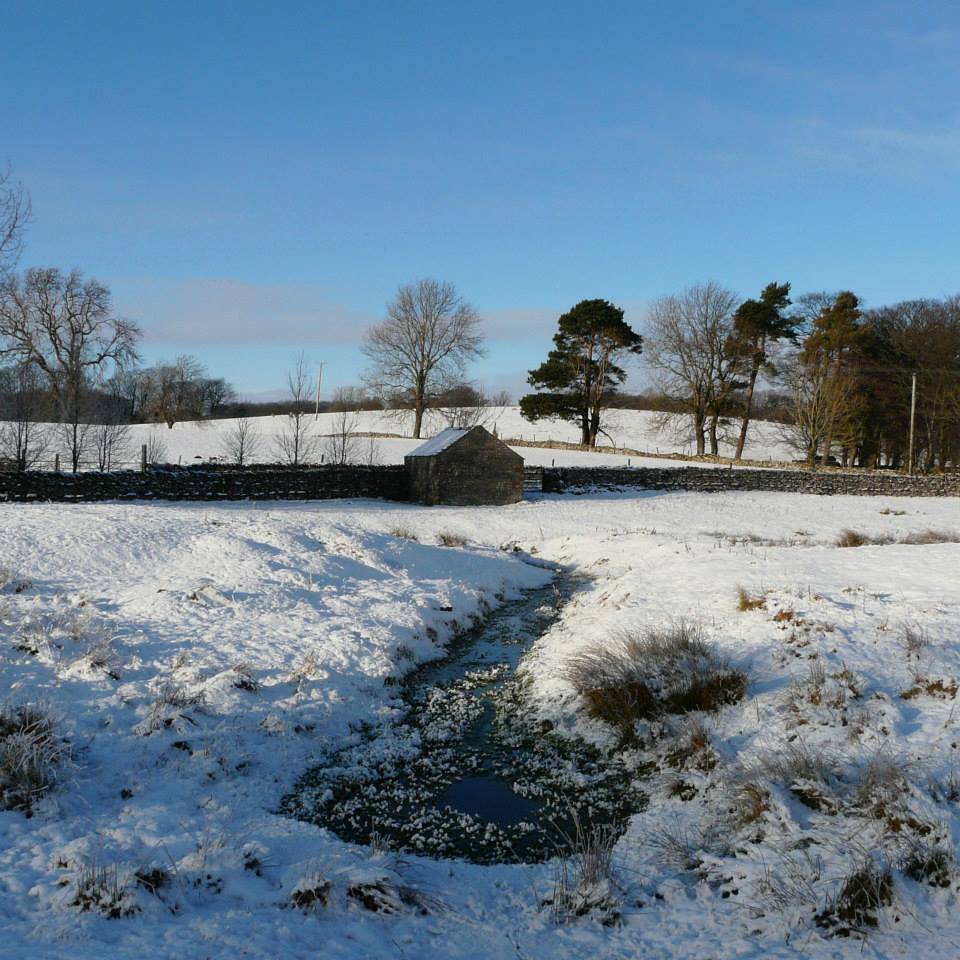
St. Helen's Well (Newbiggin-on-Lune) submitted by HeronEye on 2nd Mar 2014. St Helen's Well, Newbiggin on Lune.
The source of the River Lune.
This well pool is situated next to the mound of chapel that once stood here (picture left).
(View photo, vote or add a comment)
Log Text: St Helen's Well, Newbeggin-on-Lune, Cumbria: After seeing the Loki Stone at Kirby Steven, we followed the A685 south and west to Newbeggin-on-lune. St Helen’s Well is about 50 metres to the north of the A685 (called Fell Lane at this point). It sits almost at the junction where Chapel Butt Lane splits into two. There is parking for about three cars at this junction.
We initially took the left hand fork, walking down to where a footpath sign pointed right over the field containing the well, just before a field gate. Climbing the small stile, walking over the footbridge, we were confused as to where the well was. We understood this well was supposed to be the source of the River Lune, but there are small streams which run to the north/north east which carried a strong flow of water (there must have been a large amount of rain here recently, as the ground was incredibly boggy with large puddles across the paths, as opposed to being dry where we live). Wading through the puddles through the field gate, there was a large boggy area (complete with bull) which appeared to be the lowest point in the area, and the source of the water flow.
Retracing our steps, we asked a local lady who was walking her dog. Despite having visited this area for 34 years, she hadn’t heard of this well. Walking down the right hand lane, the well can be found by walking down the right hand side of Chapel Butt Lane (heading towards Friar Bottom Lane), with the pool becoming visible just after the first bend.
Hollin Stump Cairn
Trip No.6 Entry No.4 Date Added: 2nd Oct 2016
Site Type: Cairn
Country: England (Cumbria)
Visited: Yes on 11th Sep 2016. My rating: Condition 3 Ambience 4 Access 3
Hollin Stump Cairn submitted by HeronEye on 14th Mar 2014. Looking East to Hollin Stump cairn from the footpath to Gaythorne Plain ring cairn.
(View photo, vote or add a comment)
Log Text: Hollin Stump Cairn, Gaythorp Plain, Cumbria: From St Helen's Well at Great Asby, we headed south south west, following the single track road to ASby Winderwath Common, were the metalled carriageway turned west across Gaythorne Plain. We parked by the cattle grid on opposite Linglow Hill, where a dog walker had taken up much of the dry parking area and was waiting for his 2 lively terriers to wear themselves out tearing across the grass.
We hadn’t spotted a gateway into the field containing Hollin Stump Cairn from the road, so followed the bridlepath south. There was a gate into the field about a quarter mile from the road, but there was a herd of large cows (and a bull) surrounding the cairn, so we only go to view this from a distance.
We carried along the bridlwway to find the Gaythorn Plain Ring Cairn/Stone Row (not sure we found it, need to process the photos). The latter was visit 7/5 (not yet logged).
Lowhouse
Trip No.9 Entry No.6 Date Added: 15th Feb 2017
Site Type: Stone Circle
Country: England (Cumbria)
Visited: Yes on 12th Feb 2017. My rating: Condition 3 Ambience 3 Access 4
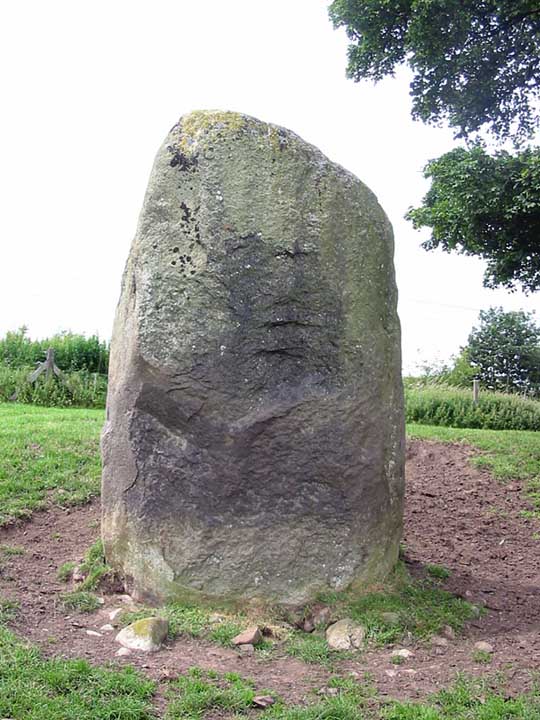
Lowhouse submitted by stu on 16th Jul 2004. Kitchenhill Bridge Stone (Lowhouse?), NY4961 3434.
Standing by the West Coast Mainline, this is a massive stone at least 3m tall. Not marked on the O.S maps.
(View photo, vote or add a comment)
Log Text: Lowhouse/Holme Head/Kitchenhill Standing Stone, Penrith, Cumbria: From Newbeggin, heading back up the M6, leaving at junction 41, turning right onto the B5305 and taking the first exit off the roundabout, we headed up the minor road signposted to Calthwaite. Where the road divides at Kitchenhill Farm, we turned right, heading over the railway line, then immediately over the small bridge over the River Petterill. At grid reference NY 49802 34135 there is a left hand turn on the bend, leading down to a small area of land by the river, used by the farmer for storing hay. There is room here for one car to park at the entrance. We walked back the short distance over the bridge over the river and went to look over the gate into the field. At first, in the gathering dusk, we couldn’t see anything, but then at the far end of the field, sheltered by a large tree, we spotted this huge grey stone.
The field is guarded by a barbed wire topped gate. I don’t like trespassing, but there was nothing in the field, so we let ourselves gingerly in and followed the tractor trail over the grass to the stone. It is huge. I spotted what seemed like other smaller (grey) stones in the base of the red sandstone wall to the right-hand side of the field. Getting closer to the stone, it sits on (what was) a lovely spot (pre railway line), overlooking the gently meandering river below.
Andrew was keen to try and get sight of two other stones in the area (and another I’d spotted travelling south on the M6 on the way down), so we drove to Plumpton, slightly further north, stopping near Plumpton Wall Farm to peer over the fields, but could see nothing. We retraced our route and headed off towards Calthwaite, stopping at the entrance to Hallrigg to peer eastwards over the fields. With the sleet hammering in our faces, Andrew got the binoculars out and spotted a stone next to Calgarth Plantation at grid reference NY 48253 37527. Looking on UK Grid Reference Finder, I couldn’t see any sign of it, although this is an old map on the Modern Antiquarian web site which would be worth investigating.
Skirsgill Standing Stone
Trip No.9 Entry No.1 Date Added: 13th Feb 2017
Site Type: Standing Stone (Menhir)
Country: England (Cumbria)
Visited: Yes on 12th Feb 2017. My rating: Condition 2 Ambience 3 Access 5

Skirsgill Standing Stone submitted by stu on 16th Jul 2004. NY5098 2874.
On the Skirsgill industrial estate near Penrith. Stone stands at the rear of the Liliput Lane factory.
(View photo, vote or add a comment)
Log Text: Skirsgill Standing Stone, Penrith: Situated in Skirsgill Business Park, just to the west of the southern part of Penrith, we’ve tried visiting this stone before, but never found it.
From Penrith, heading west across the M6 on the A66 towards Ullswater, take the very first turn into the Skirsgill Industrial Estate (easy to drive past, as it has a very short feeder lane into it). Follow the one way system into the industrial estate (note the intriguing thatched building to your left) and continue straight ahead between the two sets of industrial units. After several hundred metres, you will see a dead end with a gate leading into the field, an CrossFit Cumbria to your left. Parking can be difficult during the week, but plenty of spaces during the weekend. Walk along the dead end road towards the field, with the CrossFit building to your left. The standing stone can be found immediately at the end of this building. Was the building built to accommodate the stone, or has the stone been relocated to form part of its garden?
The face of the stone nearest to the building appears to have been quarried in more recent times, as the face is ‘squared off’. There is some modern grafitti on it.
Not the best of locations, but certainly intriguing! Could only find the Historic England listing – nothing in Pastscape.
Mossthorn Long Cairn 2
Trip No.9 Entry No.3 Date Added: 13th Feb 2017
Site Type: Cairn
Country: England (Cumbria)
Visited: Yes on 12th Feb 2017. My rating: Condition 3 Ambience 3 Access 5
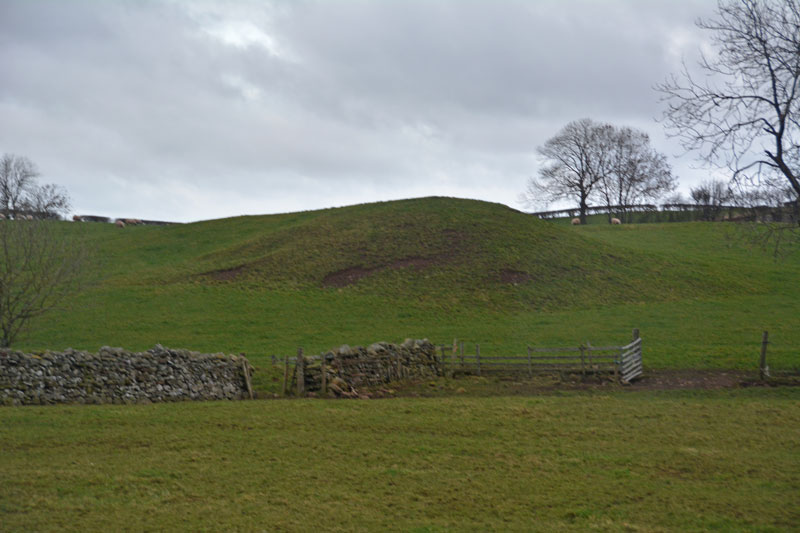
Mossthorn Long Cairn 2 submitted by Anne T on 13th Feb 2017. The long cairn at grid reference NY 48289 30440, taken from the layby outside The Wreays on the minor road from the A66 to Greystoke.
(View photo, vote or add a comment)
Log Text: Long Cairns near Mossthorn Farm, near Sewborwens Standing Stones: From Sewborwens Standing Stone(s), we drove westwards along this minor road, through the roadworks currently there, and parked in the layby outside The Wreay. The first long cairn is visible in the field immediately opposite.
Crossing the road to photograph this site, the wind chill must have been -5 degrees C, with the occasional flake of sleet. The roadworks had churned up the grass, so I waded through almost ankle deep mud to the stone wall and got a closer photograph.
We didn’t realise there was a second cairn at grid reference NY 48258 30606 until I checked on the Historic England site.
Given we want to come back and track the standing stones in Newbeggin Village at some point, I’m going to write to the farm to ask permission to walk the fields to see both long cairns at closer quarters.
Sewborrans Stone
Trip No.9 Entry No.2 Date Added: 14th Feb 2017
Site Type: Standing Stone (Menhir)
Country: England (Cumbria)
Visited: Yes on 12th Feb 2017. My rating: Condition 3 Ambience 3 Access 4
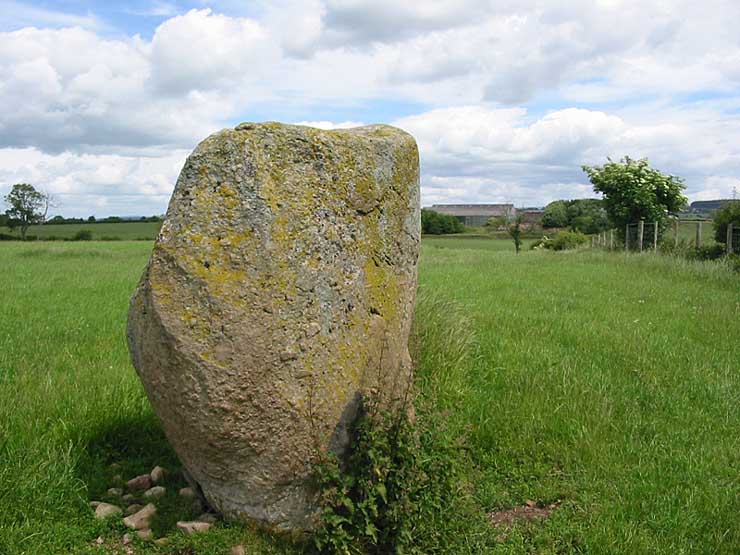
Sewborrans Stone submitted by stu on 16th Jul 2004. NY4884 2999.
1.5m high stone. Visible from the road.
(View photo, vote or add a comment)
Log Text: Sewborwens Standing Stone (and outliers), Penrith, Cumbria: From the Skirsgill Standing Stone, we made our way back on the A66, heading westwards (you can only turn left onto this dual carriageway). Turning round at the next roundabout, heading back to Penrith, we took the first left hand turn down the mnor road leading past the golf driving range and Greystoke Pillar (18th century monument to the 11th Duke of Norfolk). About 1.5 kms down this road from the A66, there is a barn on the right hand side of the road with a small (muddy) layby next to it. There is a gate into the main field to the east of the barn and the standing stone is visible next to the first fence line to the east.
There was nothing in the field, so we kept to its edge to look at the stone. Before reaching the stone, I spotted two more smaller stones in the hedge line, which looked like part of a row or avenue leading to the stone.
Having photographed the stone, I spotted more large stones against the wire fence. This modern fence has been put on top of what looked like an old (medieval?) stone wall line. There were at least three large boulders, two looking like they had been shaped and with flat bottoms, which had been moved against the old wall to clear the field.
An email to Cumbria County Council provided the information: "there are 2 smaller stones which may be related to the larger stone, beside the hedgerow bordering the B5288 and about 120 metres bearing 280 degrees from the major stone. The southernmost stone is c1.08 metres and the northermost stone is c0.75 metres.” They also added that notes from 1973 tell us: “Thompson records the ‘remnants of a stone sepulchural ring at Sewborrans”, but he doesn’t know what the original source was.
Newbeggin Wells
Trip No.9 Entry No.5 Date Added: 15th Feb 2017
Site Type: Holy Well or Sacred Spring
Country: England (Cumbria)
Visited: Yes on 12th Feb 2017. My rating: Condition 3 Ambience 3 Access 5
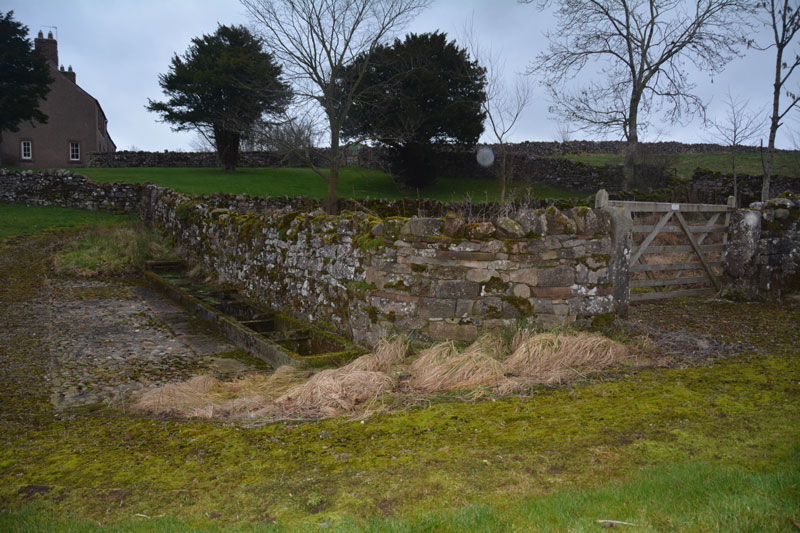
Newbeggin Wells submitted by Anne T on 14th Feb 2017. The Prospect Well, which is located on the village green in the middle of Newbeggin. The main well chamber is located behind the stone wall, with troughs set against the exterior wall. There was a fair flow of water into the troughs at the time of the visit. The water didn't taste of any particular mineral.
(View photo, vote or add a comment)
Log Text: Newbeggin Wells, near Sewborwens Standing Stone: We went originally to try and trace the standing stones, one of which stood in the wall of Rosemary House (we found Rosemary Cottage but not the house) and another which stood in the field behind.
Parking at the side of the road near Rosemary Cottage, opposite Sunbeam Well, we braved the sleet. It was getting to be dusk and cold, and light conditions were really weird. We walked the hundred or so yards between the two wells, then set off in seach of Holme Head standing stone, before it got dark.
I have since emailed the clerk of Dacre Parish Council to try to find out the location of the above stone, and to seek the landowners’ name, so we can visit.
Wikipedia, and Dacre Parish Council, record that Newbeggin is an ancient village, built on the Putnam Fault, which provides a line of springs running through the village. Neolithic burials have been found on nearby Flusco Pike and there are a number of barrows and cairns and other standing stones in close proximity.
Gilsland Spa Sulphur Spring
Trip No.146 Entry No.2 Date Added: 28th Aug 2019
Site Type: Holy Well or Sacred Spring
Country: England (Cumbria)
Visited: Couldn't find on 27th Aug 2019
Log Text: Gilsland Spa Sulphur Spring: We tried to find this well from both sides of the river. Continuing west along the river walk for about 20m, we found the path had been washed away, and not even husband-cum-mountain-goat Andrew felt comfortable walking this section of the river (he said it would have been easier to walk in the river).
We did cross the footbridge and made our way along the side of the river to within what should have been 'sighting distance' of the well, but the banks were too heavily wooded to see. Shame, as I really wanted to find this well-in-a-grotto. May return and have a second look from the Irthing Gorge walk path.
Wetheral Village Cross
Trip No.146 Entry No.3 Date Added: 29th Aug 2019
Site Type: Ancient Cross
Country: England (Cumbria)
Visited: Yes on 27th Aug 2019. My rating: Condition 3 Ambience 4 Access 4

Wetheral Village Cross submitted by Anne T on 29th Aug 2019. Standing just to the south east of the cross, looking north west towards the main part of the village, over the B6263 Steele's Bank. The cross head appears far older than the 'modern' shaft and steps.
(View photo, vote or add a comment)
Log Text: Wetheral Village Cross: a very pretty village. The steps and shaft of this cross are relatively modern, erected sometime between 1838 to 1844. The head of the cross is much weathered and appears older than the rest of the cross, although neither Pastscape nor Historic England mention this.
The cross is less than 150m to the west of the church and the River Eden. At the church, there is the remains of an Anglo Saxon cross shaft.
Greystoke Village Cross
Trip No.146 Entry No.7 Date Added: 30th Aug 2019
Site Type: Ancient Cross
Country: England (Cumbria)
Visited: Yes on 27th Aug 2019. My rating: Condition 3 Ambience 4 Access 5
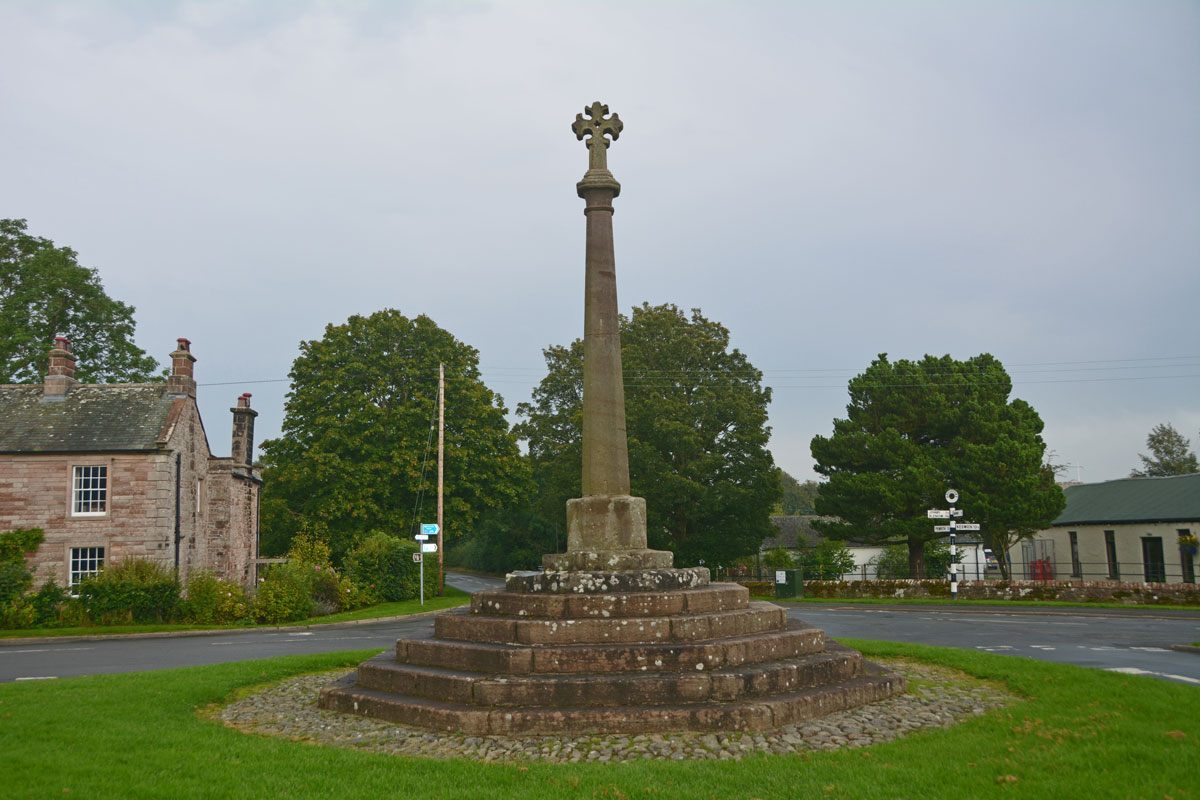
Greystoke Village Cross submitted by Anne T on 30th Aug 2019. Looking eastwards across the village green and the cross, along the B5288 which goes to Click Em and Pallethill.
(View photo, vote or add a comment)
Log Text: Greystoke Village Cross: We've been to this area before, on the hunt for the possible Newbeggin Stone Rows, but never driven into this very pretty little village. We left this until the last stop of the day (just before the rain started to hurl down), after having seen the Eyekeld Well, the village Church and the Sanctuary Stone.
There are parts of the original medieval cross built into this largely 'modern' structure. Whilst Pastscape and HE say the socket stone is original, it looked like the top three steps were original (the new socket stone had chamfered and shaped corners and was a much brighter/less weathered stone than the rest).
Sanctuary Stone (Greystoke)
Trip No.146 Entry No.6 Date Added: 30th Aug 2019
Site Type: Early Christian Sculptured Stone
Country: England (Cumbria)
Visited: Yes on 27th Aug 2019. My rating: Condition 2 Ambience 3 Access 5
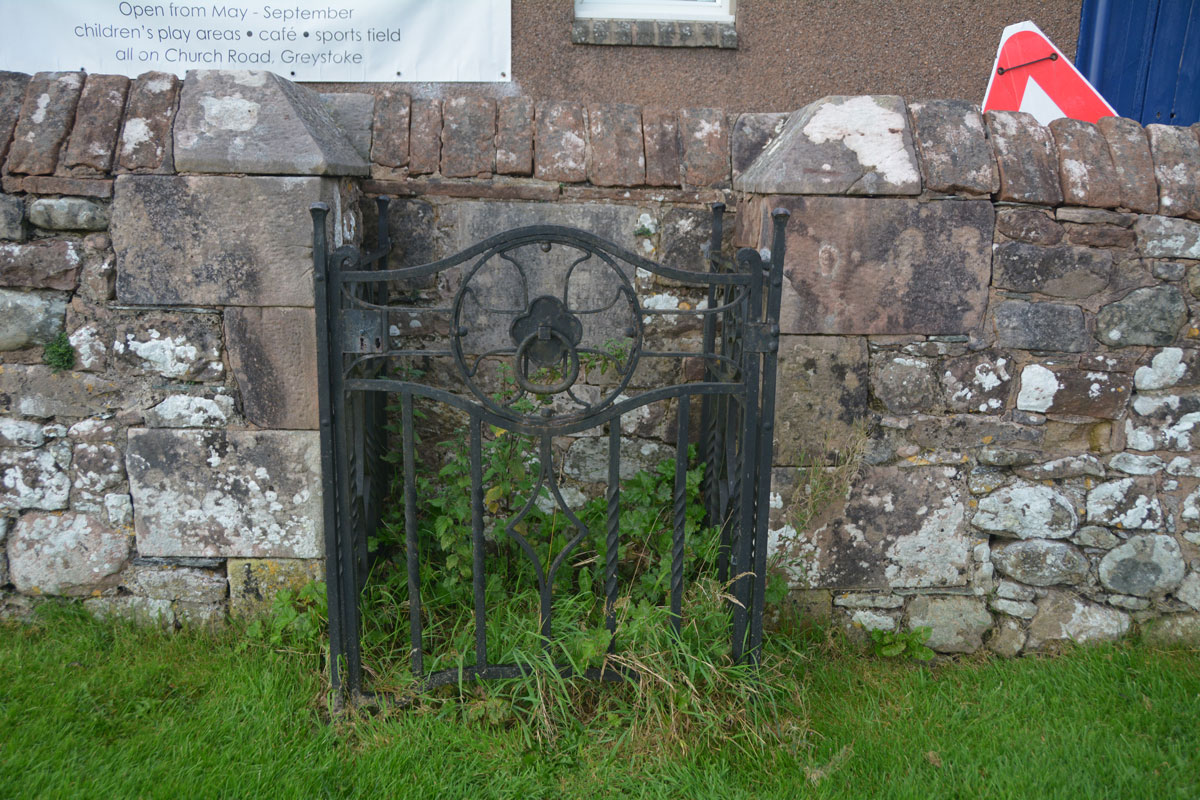
Sanctuary Stone (Greystoke) submitted by Anne T on 29th Aug 2019. Nothing could be seen of the actual sanctuary stone, which lies virtually flat to the ground within in a concrete base. It used to lie some 10 feet south of its current position. With a very busy heated, outdoor swimming pool, I didn't dare lean over and pull the nettles away (perhaps I should have asked permission at the swimming pool).
(View photo, vote or add a comment)
Log Text: Greystoke Sanctuary Stone: We didn't know this stone was here until I read the church guide book as we walked around the church. There is also a plaque stone somewhere, but we'd almost run out of time today. This stone was disappointing, as it wasn't visible underneath a dense covering of nettles and weeds. I'm now kicking myself for not asking at the swimming pool reception a few metres away if it was possible to pull a few of these away to take a closer look. There was a photograph of the cleared enclosure on the Old Cumbria Gazetteer.
Winderwath Stone Circle
Trip No.13 Entry No.4 Date Added: 28th Mar 2017
Site Type: Stone Circle
Country: England (Cumbria)
Visited: Yes on 25th Mar 2017. My rating: Condition 3 Ambience 4 Access 5
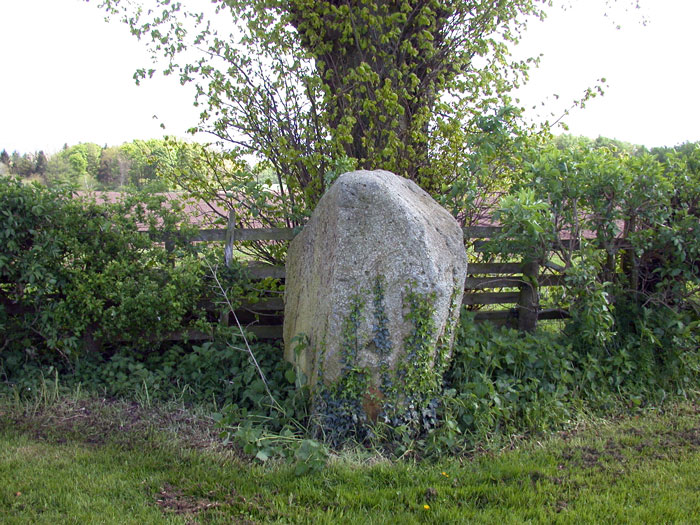
Winderwath Stone Circle submitted by nicoladidsbury on 11th May 2005. Winderwath standing stone This stone stands by the lane leading to Winderwath, and its magnificent gardens.
(View photo, vote or add a comment)
Log Text: Winderwath Stone Circle, Penrith: After our 'stone hunt' around Newbeggin and Newton Reigny, by this time it was gone 5pm and there was no hope of getting to Haweswater to look at the standing stones on Four Stones Hill before dark, so we set off to Winderwath. The Visit Cumbria website says in its entry for Winderwath Gardens: "There used to be a stone circle in the field adjacent to the lane that leads down to Winderwath, which was destroyed. Its stones were thrown into the River Eden nearby, except two – one stone remains standing by the lane, and a further stone lies behind the hedge, at the edge of the field." Note: this site is not included on the list of stone circles @ Photographer’s Resource and I could find no other reference to it on the web.
Sited on the minor road to Winderwath Gardens, it was interesting to find this tiny little turn off the A66 east. From Penrith, go passed the entrance to Centre Parks on the opposite side of the road and take the first road to your left, signposted to Culgaith. Following this little road which takes you past Woodside, Low Woodside and Winderwath Farm before taking a left to Winderwath Gardens, we’ve never seen so many rabbits scuttling about across the road and in the fields.
These stones are on the right hand side of the road as you drive down towards the gardens, about half way down the drive. This is again in a lovely valley, but being in an estate, it looks as if the ground has been heavily improved and levelled.
After having found the first stone, which seemed to have a couple of worn single cup marks in 2 of the faces (quite distinctive from the weathering patterns on the top of the stone), we peered over the hedge to find the second stone. It appears the tree in the fenceline is sitting on top of a few other smaller stones. The second, larger stone can hardly be seen from the driveway, so we found a gate in the top end of the field and quickly ran down to take a look. If someone had been around, we would have asked nicely.
Newbeggin Stone Row
Trip No.14 Entry No.2 Date Added: 28th Apr 2017
Site Type: Stone Row / Alignment
Country: England (Cumbria)
Visited: Yes on 25th Mar 2017. My rating: Condition 2 Ambience 3 Access 4
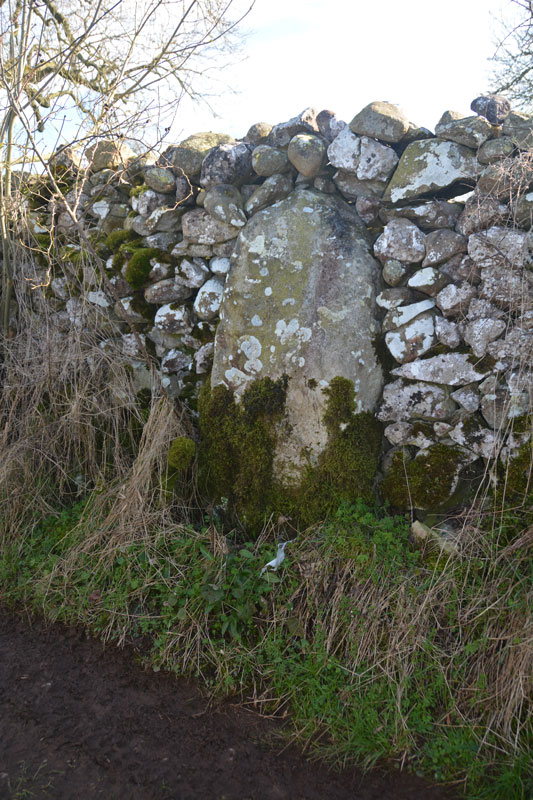
Newbeggin Stone Row (Possible) submitted by Anne T on 28th Mar 2017. This stone is built into a stone wall on a footpath which follows the Carlsike Burn, around Hoghouse Hill to Newbeggin. Located at NY 48058 29531. Note: 3rd April 2017. The Lead Officer for the Historic Environment and Commons says "This is slightly more interesting. I would not like to guess at when this might have been erected."
(View photo, vote or add a comment)
Log Text: Newbiggin Stone Row, Near Penrith: Following our first visit to try and find the standing stones mentioned on the village website, but drawn a blank, we did find 2 of the 4 wells, and recorded these in photographs. An email to the Parish Council, who'd featured one of these stones on their website, resulted in us being put in touch with Dr. Alan J Rich, the local historian. He was enormously helpful and emailed me across a map of 5 of the stones to be found around the immediate bounds of the village.
Also intrigued by The document “The Prehistoric Remains on Moordivock, near Ullswater” by M. Waistell Taylor MD, FSA, dated 1885 on page 342 and 343 talks about “remnants of former alignments of megaliths may still be made out elsewhere, in various localities in the district around Penrith, a few appearing as Standing Stones, and some partially sunk, or walled into the breast of fences. For instance in the direction from the S end of the village of Newton Reigny, by Mossthorn, on over Pallet Hill to Newbiggin; also from Sewborrens over the Riggs Farm to Newbiggin some few exist, and I have seen old people who remembered the removal of many of these stones at the beginning of the century. These lines may have been in connection with the barrows and stone circles, of which the dilapidated remains and half buried relics are frequent over this locality.”
Taking advantage of the sunny, spring weather, and armed with Dr. Rich's maps and book, we headed back to Newbiggin for a wander around the lanes and pathways in and around this long, linear village. In total we saw a total of 10 possible standing stones, and I've emailed details to the County Historical Officer to see if these can be verified as such, as they are not mentioned on the OS map. Curiously, plotting the grid references on UK Grid Finder, apart from the stone near Bell Mount, there is an alignment running north-east from Newbiggin towards Newton Reigny.
Shapbeck Plantation
Trip No.15 Entry No.1 Date Added: 3rd Apr 2017
Site Type: Stone Circle
Country: England (Cumbria)
Visited: Yes on 2nd Apr 2017. My rating: Condition 3 Ambience 4 Access 4
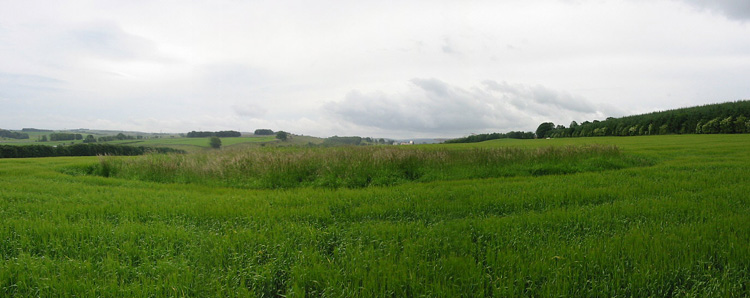
Shapbeck Plantation submitted by stu on 16th Jul 2004. NY552 188.
General view of the overgrown stone circle.
(View photo, vote or add a comment)
Log Text: Shapbeck Plantation Stone Circle: Our first stop of the day, whizzing off the M6 southbound at Eamont Bridge and travelling on the A6 through Clifton & Hackthorpe to Shapbeck Gate. There, a side road leads to a bridge across the River Leith, but there was no parking to be had. We turned back northwards up the A6 and parked in a layby some ¼ mile north of the footpath leading up to Shapbeck Plantation. We took our lives in our hands walking back to the footpath, with cars and motorbikes travelling fast along the road, and the verge was lumpy and bumpy and difficult to walk along.
Finally reaching the footpath, almost opposite the road leading to Southfield and Stonygill Bridge, we turned west over the fields towards Shapbeck Plantation, I was glad I had worn my wellies, as the gates into the fields were deep in muddy water. Careful of the stock in the first field, we crossed through the gate into a second field, where the footpath vanished – it had been ploughed out. Following the dry stone wall line up the hill towards the plantation, it was only when we had almost reached the top of the field that a fenced off area to the northern side of the field came into view.
Walking towards this, it was clear the farmer had been using this area as a dump for old metal items and other stones, although an inner and outer circle were clearly visible. It looked as if the circle had been built on a slight mound, with a ditch around the outside. At this time of year, there wasn't much vegetation, so it was possible to see lots of the stones.
Without the plantation, there would have been views 360 degrees around the site. Even today, this area was busy, busy, busy, with the A6, M6 and West Coast railway all intersecting and intermingling in the valley below. Walking across the fields, many of the smaller stones poking out of the earth had a very distinctly green tinge.
Definitely worth braving the traffic to visit this site.
